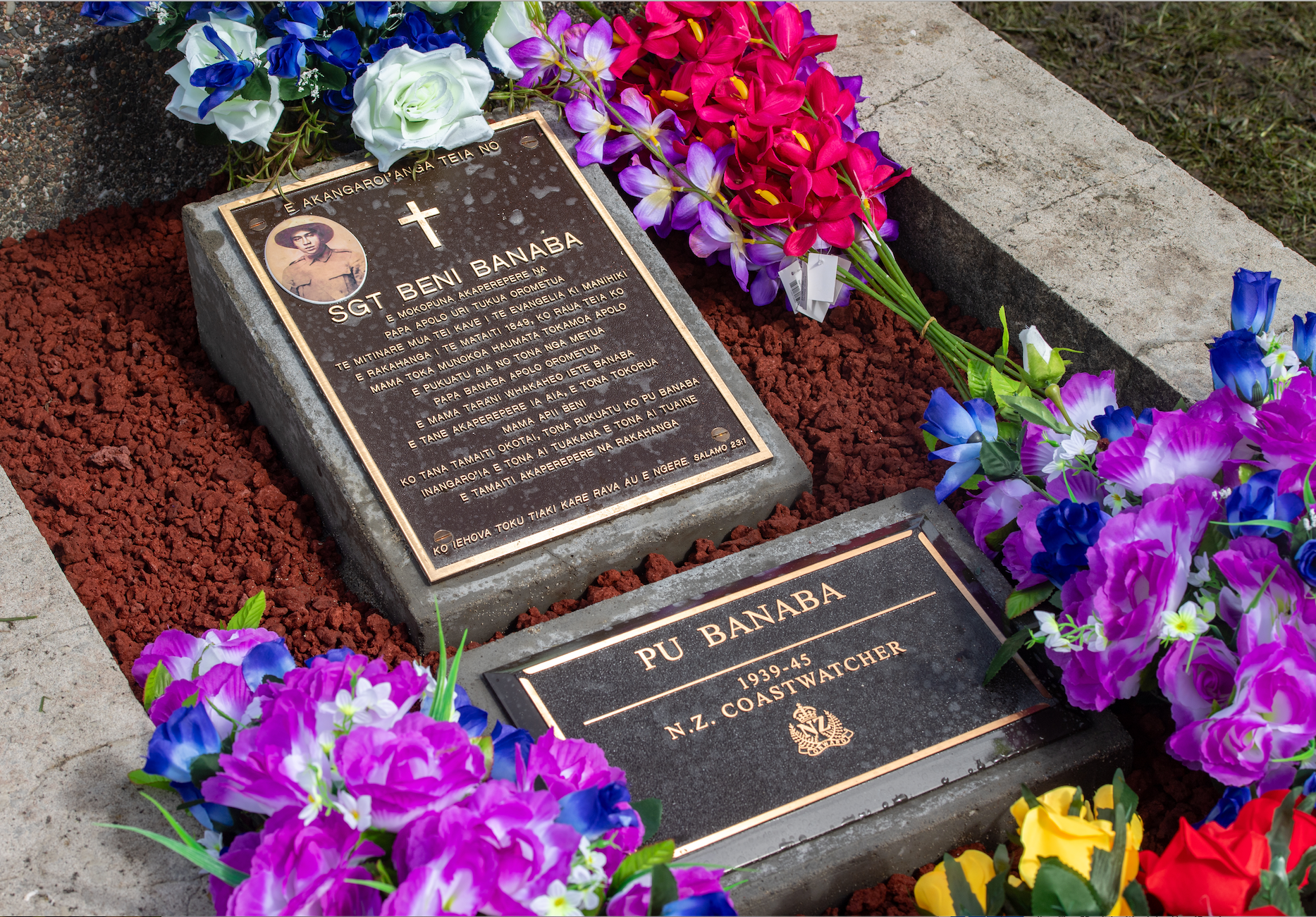Cook Island coastwatchers to be honoured at ANZAC day and beyond
Tuesday 23 April 2024 | Written by Supplied | Published in Features, Memory Lane

Pu Banaba was the first Cook Islands coastwatcher to have his service plaque unveiled in 2023.Supplied/24042220/24042221
The Cook Island community is preparing to commemorate the service of soldiers and local heroes this Anzac Day in New Zealand.
Up to 60 Cook Islanders served as civilian coastwatchers in WWII, working from isolated atolls as lookouts for foreign aircraft or ships and reporting back to New Zealand headquarters.
Cook Island Anzac committee member Frances Topa Fariu says many are yet to be formally recognised for their service.
“[They] were our heroes during those years, who were called to be the watchers of perhaps enemy ships, patrolling our exclusive economic zone back in the Cook Islands.
“They probably didn’t realise this huge undertaking that they’d been tasked to do, but just rethinking the effort that they had made to stand as our police, our watchmen, our guards during those years.”
The coastwatching operation began as a volunteer exercise by the local Boys’ Brigade, before being replaced by a group of WWI veterans. On 7th May 1941, a memorandum to the Secretary of the Cook Islands Department in Wellington suggested paying the "natives" would be more reliable.
“Serving in an official position, too, also impresses a native with a spirit of importance and thus instill a greater degree of responsibility than he would otherwise have,” the memorandum stated.
Fifty-eight stations were set up around the Pacific, with 11 in the Cook Islands, with some coastwatchers as young as 16 tasked with being the lookout for enemy aircraft or ships. One of the coastwatchers was 18-year-old Sir Tangaroa Tangaroa, who later became an MP for Penrhyn and the first Cook Islander to be named as the Queen’s Representative.
Declassified documents show pay rates were only a tenth of what their European counterparts were receiving. In November, 1945, ten coastwatchers sent a letter to the Secretary for Island Territories, asking for overtime pay, clocking up to 93 hours per week.
“We had to take up our positions, usually about 400ft above sea level, and we had to remain on duty until 6pm. At Arorangi, it took one hour to reach the watching post. In Avarua, it took a half hour.
“We estimated that we worked 3 hours overtime each day … we believe that we have been unfairly treated and are therefore placing the matter before you, hoping for favourable consideration.”
Proper recognition of service
In July this year, previously unattested coastwatchers from the Cook Islands will be recognised, and their families presented with certificates at Government House in Wellington. Families will also be able to attach service plaques to headstones, and an online historical record of their service will be published online.
Other Pacific coastwatchers were recognised in 2022, with the then Minister of Defence Peeni Henare saying “this is long overdue recognition of the Pacific Island coastwatcher and the important role they played in our early warning system in the Pacific”.
“With Japanese advances into the Pacific in 1942, these stations became very dangerous places. The brutal killing of our coastwatchers on Tarawa and the suffering of those captured showed the real risks of this service.”
Last year in Auckland, the first coastwatchers plaque was unveiled for a Cook Islands civilian recognising the service of radio operator Pu Banaba.
While Banaba is buried in Rarotonga, the plaque was placed on his father's grave, Sergeant Beni Banaba who served in the 2nd Rarotongan Contingent in WWI.
Bobby Nicholas is a researcher of Cook Island veterans, documenting the lives and photos of hundreds of soldiers and restoring headstones in the Cook Islands. He is currently looking for more information about NZ Coastwatcher Rubena Robati who served from 1939-1945. He was stationed with John Henderson and Herbert Pittaway. Nicholas has photos of Robati’s wedding in Rakahanga, but would like to speak to his descendants before making these public.
These other names have been identified, but authorities are still trying to find them or their next of kin: Tupero, Tere (Tutere); Tiro, T (Atiu); Tariu, Jasper/John (Pukapuka); Pamatatau, Pamatatau/Pama (Mauke); Browne, E; Niarua, N (Manuae); Eteke, Enua; Tuteru, Tere; Teariki, Teruarau; Raina, Tanu; Pharaoh, Maka; Tuakana, Taramai; Vaea, Keu; Tutua, Ngaputa; Rere Wichman, Papehia; Pirangi, Tutai; Toru, Terii; Matangi, Au (Pukapuka); Roi, Iripa (Suwarrow); Kino, Tariu (Nassau); Te Mata, Tiare (Nassau); Meao, Rai (Nassau); Make/Makea, Metua (Nassau) and Pamatatau, Vetevihi (Niue).
Anyone with information about a Pacific coastwatcher or families wanting to make contact with the research team can email: historyenquiries@nzdf.mil.nz
- Khalia Strong/Pacific Media Network















































